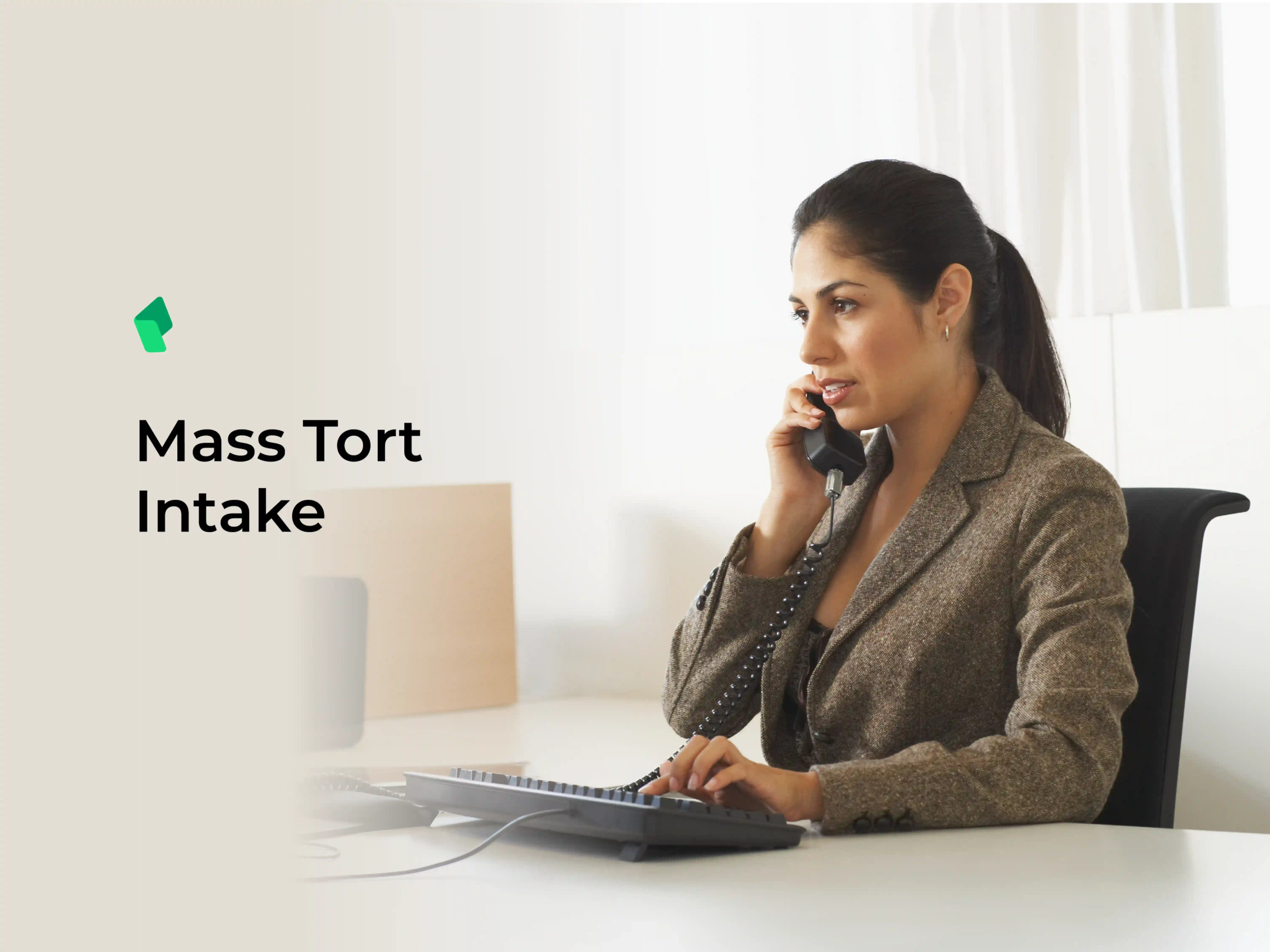Mass torts involve large groups of claimants affected by a single issue, such as defective drugs, faulty products, or environmental disasters. These aren’t standard one-plaintiff personal injury cases. Rather, in mass torts, a lawyer works with many clients, all with similar complaints against one or more defendants.
Here’s where an effective client intake process steps in. Since you will be dealing with an influx of clients, having a smart, efficient legal intake system means you’re able to identify solid cases quickly and set your team up for smooth case management.
Get your client intake process right, and you’ve got the backbone of a successful mass tort campaign.
What is Mass Tort Intake?
Client intake is about getting the facts—collecting personal information, injury details, and relevant documents to decide if the case is worth pursuing. But, as we established, mass tort intake can be tough.
In mass torts, hundreds and sometimes thousands of people file claims about the same issue. Efficiency is essential, so systems that can rapidly assess whether someone has a viable case are crucial.
Not every person who comes knocking is going to have a case. This is why tort intake professionals rely on vetting leads quickly, making sure they fit the mold of the mass tort—did they suffer harm from the same defective product? Did they take the same drug? If yes, you have a case on your hands.
Why Legal Intake Strategies are Vital for Mass Tort Cases
When hundreds of inquiries are on the line, people will slip through the cracks if your legal intake process isn’t airtight. Miss out on a good lead? That’s a lost cause. You need to sift through the opportunities efficiently, and having a solid intake system helps you catch good leads without wasting time on dead ends.
The right tort intake strategy can help your firm:
Avoid missed leads: With hundreds of inquiries, an airtight intake system ensures you capture good leads and avoid missing opportunities.
Sort leads efficiently: A streamlined intake process helps you focus on promising cases, filtering out dead ends and maximizing your efforts.
Manage data better: Organized client info—personal details, medical records, injury data— is easier to access and enhances firm productivity.
Strengthen client relationships: Clear communication from day one builds trust and keeps clients informed, which is crucial when managing hundreds of claimants.
Stages of an Effective Mass Tort Intake Process
Mass tort intake for lawyers can be separated into different stages, which are:
Initial Contact
When potential clients first reach out—whether through phone calls, online forms, or ads—timely response is critical. A 24/7 intake service can ensure that no inquiry is left waiting and that every lead is captured as it comes in. Quick, responsive communication sets the tone for future interactions and makes potential clients feel heard.
Pre-Screening
In this stage, basic details are collected to see if the client fits into the mass tort framework. You’re gathering key info like the injury type, when and how they were exposed, and some initial medical records. The goal here is to filter out anyone who doesn’t meet the criteria early on so you don’t waste time chasing leads that won’t pan out.
Client Qualification
After pre-screening, it’s time to verify whether the claimant's case lines up with the mass tort’s specific criteria. This is where the rubber meets the road—getting confirmation that the client qualifies before moving forward. You may need to consult medical experts or do a more in-depth review of records.
Client Onboarding
Once you’ve qualified the lead, it’s time to bring them on board. This involves signing the retainer agreement and obtaining necessary legal documents, like medical authorizations. Most firms use e-signature tools to make this process faster, cutting down on mailing time and reducing delays.
Ongoing Communication
After onboarding, the next step is keeping the lines of communication open. Regular updates help maintain trust, especially when you’re handling a high volume of clients. Clear communication makes sure your clients stay in the loop and feel confident throughout the legal process.
Strategies for Effective Mass Tort Intake
Mass tort strategies are essential for ensuring your firm can handle a large volume of inquiries effectively and without missing valuable leads. Here are a few best practices:
Use online intake forms that are easy to fill out and accessible on any device.
Leverage CRM software to manage lead tracking and keeping tabs on every potential client. CRMs help you automate reminders and follow-ups so you can respond quickly without losing any leads. For onboarding, e-signature tools save time and streamline the process—clients sign contracts online, which speeds everything up.
Setting clear qualification criteria. Know what counts as a qualifying case, such as exposure period, product involved, and medical history. Standardize your verification process to ensure that every lead gets the same treatment. Uniformity ensures no client is missed or mishandled.
Set expectations early. Explaining each step of the intake process and how long everything might take. prevents client confusion and frustration. Automated systems can help you reply quickly to incoming inquiries, which is critical because if a potential client doesn’t hear back fast, they’re more likely to go to another firm.
Managing Leads from Mass Tort Intake
When it comes to tracking leads, a solid CRM tool is essential. You want to know exactly where each potential client is in the intake process—whether they’re at the initial inquiry stage or already onboarded. By categorizing leads, you can prioritize follow-ups and ensure no lead slips through the cracks.
Be sure to set up automated email and text message campaigns to keep potential clients engaged. This ensures regular touchpoints with leads who may not have signed yet, keeping your firm top-of-mind as they consider their options.
With mass tort cases, you’re handling sensitive data, including medical records. Make sure your systems are HIPAA-compliant, and that client information is stored securely. This not only protects your firm legally but also reassures your clients that their personal data is safe with you.
How CASEpeer Can Help Provide a Seamless Mass Tort Intake Process
CASEpeer is specifically designed to streamline case management and intake management for personal injury law firms, including those who handle mass tort cases.
Here are some ways that CASEpeer helps lawyers handle client intakes efficiently:
Customizable online intake forms: Easily create tailored forms to gather essential client information, reducing intake time and ensuring you collect the right data upfront.
Automated qualification tools: Automate the lead qualification process, prioritizing cases that need attention and allowing your team to focus on the most important ones.
Secure client portals: Provide clients with easy access to upload documents and track their case status, boosting transparency and client satisfaction.
Integration with CRM systems: CASEpeer integrates with CRM systems to ensure every lead is tracked, organized, and followed up on efficiently.
To see how CASEpeer can revolutionize your firm's client intake process, book a demo today.
About the author

Justin Fisher Content Writer
Justin Fisher is a content writer and SEO strategist for leading legal software companies, including MyCase, Docketwise, and CASEpeer. He specializes in writing about emerging legal technology, financial wellness for law firms, and more.
